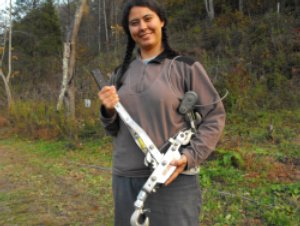
Multiple Use's for a Hand Winch
We have a four ton hand winch that really pulls more than its own
weight around here. Some folks refer to them as a "come along", I call
ours an essential tool for pulling a truck out of the mud, stretching
barb wire tight, or bringing down an old house as you can see in this short video
clip. There are several varieties to choose from. The ones
rated for two tons can be had for 10 or 15 dollars; we got lucky and
found a four ton model for only 20 bucks at the Bluff City flea market.
You should expect to pay somewhere between 35 and 50 bucks for the four
ton if you want to order
it online.
I have a designated gear bag for our winch that includes a heavy duty
tow strap, a ten foot stretch of cable with loops on each end, and a good old fashioned chain. These items are
needed to attach your winch to a tree, heavy duty vehicle, boulder,
etc. Extreme care should be taken when operating any type of winch
where several hundred or thousand pounds are being held. The cable can
end up holding a tremendous amount of potential energy, and if there is
a
break or slip then that energy needs to go somewhere, and if you're in
its way it might be the last mistake you make. I try to imagine the
path the cable might take if it did break, and stay clear and make sure
any bystanders are plenty out of the way.
each end, and a good old fashioned chain. These items are
needed to attach your winch to a tree, heavy duty vehicle, boulder,
etc. Extreme care should be taken when operating any type of winch
where several hundred or thousand pounds are being held. The cable can
end up holding a tremendous amount of potential energy, and if there is
a
break or slip then that energy needs to go somewhere, and if you're in
its way it might be the last mistake you make. I try to imagine the
path the cable might take if it did break, and stay clear and make sure
any bystanders are plenty out of the way.
Simon Faure invented a new kind of hand winch during World War 2. He
named it the Tirfor and due to its unique design these winches
are capable of working in any position, horizontal, vertical, or
angled. What really sets the Faure winch apart from a simple come
along is its shear pin. When the machine reaches 125% of it's capacity
a metal pin inside the winch breaks, alerting the operator that any
more pulling would be dangerous. Replacement pins are stored in a
compartment on the handle. Be ready to pay between 300 to over 1000
dollars for such a tool. More details can be found at this website.
Want more in-depth information? Browse through our books.
Or explore more posts by date or by subject.
About us: Anna Hess and Mark Hamilton spent over a decade living self-sufficiently in the mountains of Virginia before moving north to start over from scratch in the foothills of Ohio. They've experimented with permaculture, no-till gardening, trailersteading, home-based microbusinesses and much more, writing about their adventures in both blogs and books.
Want to be notified when new comments are posted on this page? Click on the RSS button after you add a comment to subscribe to the comment feed, or simply check the box beside "email replies to me" while writing your comment.
